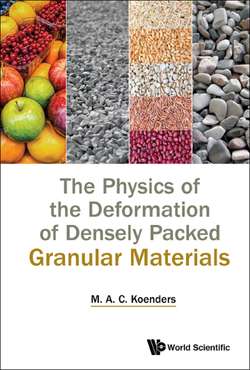Читать книгу The Physics of the Deformation of Densely Packed Granular Materials - M A C Koenders - Страница 12
На сайте Литреса книга снята с продажи.
1.5The frictional interaction
ОглавлениеOne effect that is without doubt very important in the constitutive contact law is the effect of friction and to introduce that the normal force alone is insufficient; a tangential force-displacement rule must be added to the description.
The friction effect is obviously plastic. When the force ratio (that is the magnitude of the tangential force to the normal force) reaches a certain value μs, persistent further motion will not change it; a constraint has become active that keeps the force ratio constant. This was established by [Coulomb, 1785] (based on measurements by [Amontons, 1699], see [Heyman, 1972] for the history of the subject and many more references). The concern here is essentially with dry friction. [Bowden and Tabor, 1956] treat the subject from an engineering standpoint and also extend their treatment to include effects of lubrication. On unloading the contact may recover its elastic properties, though not necessarily with the same elastic constant as the loading curve. The process is illustrated in Fig. 1.3, where F||/F⊥ is shown as a function of the tangential contact displacement D||. In this figure the spring constants for loading and unloading are taken as constants; when a nonlinearity is taken into account the straight loading and unloading lines become curved.
Figure 1.3. Illustration of the Coulomb friction principle.
It is clear that when behaviour like this is encountered an incremental formulation is necessary. The normal and tangential motion become coupled, so a general form for the incremental contact response relates the force increment to a displacement increment
The elements of the matrix are the spring constants. Some properties of these are easily determined.
In the elastic state there is an incremental potential, , from which the force increment is obtained by partial differentiation. It follows immediately that for this case the matrix must be symmetric: k⊥|| = k||⊥. If, in addition it is assumed that normal and tangential increments are uncoupled, it follows that the off- diagonal elements vanish. This does not preclude anisotropy with respect to the direction of the contact surface, so k⊥⊥ need not be equal to k||||. If they are assumed to be equal then the one-parameter model k = k⊥⊥δ follows, which has the pleasant property that it is invariant under rotation, so the direction of the contact is irrelevant (the Kronecker delta δ is formally introduced in Section 2.2). For contacts that only interact through the normal force (frictionless) k// = 0.
In the frictional sliding state an additional force increment added to the state (F⊥, F//) should leave the ratio F///F⊥ constant at the value of μs. Taking F⊥ and F|| both positive, leads to the following
In other words
This constrains the elements of the matrix k by the additional relation
which must hold for arbitrary displacements, hence
So, for this case the matrix k takes the form
In many instances the increase in the tangential force increment for purely tangential motion is negligible, implying that k|||| = 0. The frictional state is then entirely described by two parameters, k⊥⊥ and μs.
When F|| is negative, μs is replaced by –μs; otherwise the relations remain the same.
Unloading from the frictional state is detected by checking what the response would have been for an elastic increment (this could in principle be brought about by an increase in the normal force). If this decreases the magnitude of the tangential to normal force ratio, the next increment should be evaluated using the (unloading) elastic law. Therefore, the frictional interaction is predictive, but must always be followed by a verification.
Friction in two dimensions is covered in the literature. [Ruina, 1980] and [Ruina, 1983] discusses the sliding state once the initial friction criterion is passed. On continued motion the value of μs falls by a small amount — the friction is said to change from a static value to a kinetic value. In addition, an extra stress that is proportional to the speed of continued tangential motion needs to be introduced (this effect is sometimes known as the Ruina–Dieterich law: [Dieterich, 1979, 1981]). It should be emphasised that the measurements that underlie this law are done on blocks of rock material. In these experiments there are always many contacts at the same time, while for the present application two particles share one contact, which is approximately a point-contact, that is, a very small contact area between two convex surfaces. Direct application of the Ruina-Dieterich law may therefore not be appropriate.
While the frictional effect has been measured extensively, the actual mechanism of the contact mechanics that lead to friction is relatively unexplored. [Villagio, 1979] has put forward some interesting ideas, though they have so far not been widely followed up.
